ACES Family Academies Shows Youngsters: "It's Not Your Parents' (or Your Grandparents') ACES Anymore!"

Counterclockwise from the right: ACES alum Scott Shearer with his wife Barbara and granddaughter Rayna visiting the ACES Family Academies.
“To be able to tell our story, I think that's what's so important—so people can see all of these opportunities and see what ACES is today.” – ACES Family Academies Director, Tina Veal
July 19, 2017
They came from near and far, back to their Alma Mater…back to ACES, where they got prepared for their careers and for life. The trip was nostalgic—visiting old haunts, reminiscing, and marveling at the many changes on campus. But as they returned with their children (or grandchildren) in tow, they had a greater purpose: to introduce the next generation to the center of learning that helped to make them who they are today, to bond with them while doing a variety of fun learning activities, and to possibly do a little recruiting to Illinois.
For instance, Scott Shearer came back with his wife and granddaughter. Shearer majored in agricultural economics and graduated from Illinois with a Bachelor’s Degree in 1970 and a Master’s in 1975. Shearer explains why he participated in ACES Academies.
"Well, I thought it was a great program,” he says, “especially for our granddaughter, to give her a chance to see what university life is like and all of the possibilities, subjects she could learn things about. So this is her second year back."
Shearer says it was fun being back on campus, and “It's changed a great deal!" But he wasn’t just referring to all the new buildings.
“There are so many new programs that are being offered [compared to] when I was here. But, it's a reflection of what the world's like, what the economy's like, and what students need to be prepared for. They prepare for their time in the workforce."
Shearer, who appreciated being back on campus, shares the impact that going to school at Illinois had on his life.
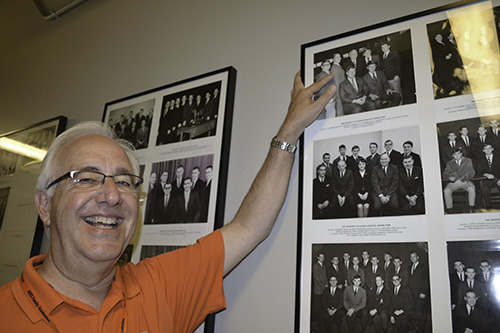
Shearer, pointing to a picture of himself on the Livestock Judging Team when he was a student at Illinois.
"Well, I'd give the University of Illinois a great amount of credit for my professional career. It gave me a foundation for my career. It opened up opportunities for me. It was a great place for a solid education and lifelong friends and opened up possibilities for the world for me. So, I give the University of Illinois great credit for giving me a foundation for my career."
Accompanying Shearer, along with his wife Barbara, was his granddaughter, Rayna Brunk, who was having a blast. She says it was not only fun, but exposed her to some out-of-the-ordinary things:
“So, my classes, you get to do things that you don't usually get to do. I'm from the city, so you don't get to do a lot of things back there with animals." Like sticking her arm inside a cow's stomach.
So did gramps’ recruiting gambit work? Does Rayna think she might come to school here?.

Lane Richardson suited up to visit a real bee hive at the Pollinatarium.
“Actually, yes indeed,” she affirms. “I've been trying to get very good grades, and I'm going to keep that up. So, I'll be able to get in here one day.”
To this reporter’s caveat, “You know, it's a very, very good school." Rayna confidently acknowledges: "Yes!"
Another ACES alumna, Keri Richardson, reports that she and her son Lane actually attended ACES Academies together for the first time last year. It was his birthday present. “He's just really into learning and doing different things,” she explains. “When we got the email, we signed up, and we're back again this year.”
Richardson appreciated being back on campus and acknowledged that while many things had changed, some were still the same as when she was here.
“It's different because there are so many changes and different buildings,” she admits, “but Mumford still looks exactly the same…like the worn steps on Mumford. “I told my son when we were walking up, ‘The stairs were always worn,’ because, I think, of years of use, and he noticed that too when we were walking up the stairs today.”

Lane and Keri Richardson show off the piggy banks they made at "Of Pigs and People."
Lane, who likes learning, would agree that, yes, he learned a lot.
For one, he appreciated that there were more options for classes this year. He also enjoyed visiting the Japan house, possibly because he “really liked the candy that they brought out 'cause it tasted just like sugar.”
He and Mom went to “Maybe Money Can Grow (Not on Trees),” where they each made a piggy bank. And it sounds like Lane possibly became a convert to life-long saving.
“We learned about interest, and how to save. And if you save in the bank, interest will go up so you can make more money. And we learned that with one penny, if you save, save, save, the interest could go up to millions of dollars.”
Lane also enjoyed “Feed the Bees,” a trip to the University’s Pollinatarium, where he got to do some things he’d never done before.

Lane holds the smoker at the "Feed the Bees" session on Thursday evening.
“I really like that we got to put a new pot on the beehive. I used a crowbar to [pry] up the lid. I really liked how she was saying the bees know when storms are coming, because they'll be flying around to protect. And I really like how the smoke will just calm them down and not hurt them."
In its third year, the 2017 edition of ACES Academies was a 2-day event for the first time this year. Providing a myriad of activities, all seven ACES departments hosted one or more 90-minute sessions of mostly hands-on activities which touched on the gamut of subjects dealt with in ACES.
For instance, some activities dealt with the birds and the bees. In “Bird’s the Word: Exploring Avian Ecology and Conservation,” the kids got to actually catch wild birds with a net so they could see the birds up close while they learned about them and some of the research being done.
In “Feed the Bees” (see above), participants suited up in protective gear and helped change a frame in an operating bee hive.

Above: a young participant to ACES Academies uses the proper technique to say "Hello!" to a strange dog.
Below: the dog hams it up for the camera.
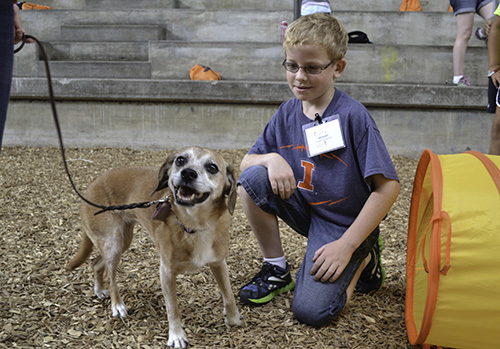
In one activity, “Man’s Best Friend,” participants learned about dog behavior, plus learned how to take care of their pet, and gleaned training tips. This reporter even learned something: to say “Hello” to a dog a non-threatening way: touch its nose with your fist from a kneeling or squatting position.
Sessions also dealt with larger animals. In “Of Pigs and People,” participants examined piglet brains and watched a demonstration of how to study neurosciences. ACES Family Academies director, Tina Veal, shares the goal of this activity (and many of the others), “As we look at this program, we're trying to make sure that people see that there is a true science behind agriculture and human science.”
In “Where’s the Beef: Getting to Know Cows Inside and Out," participants learned about cows and cattle nutrition. And part of learning about the insides of a cow was getting to put their arm inside of one!
Of course, since agriculture is about producing food, several sessions were about food...both for animals (“What’s in My Food, Dude? Behind the Scenes in Pet Food”) and people. For example, “Food Challenge” was actually a cooking contest like on the Food Network. Kids got to choose from multiple ingredients, then made some kind of product that they then had to sell by getting up and talking about what they had made, why they had made it, what the ingredients were.
Other food-related sessions addressed products from animals, such as in one activity, “The Secrets of Sausage.” In the “Magical Milk Lab,” participants actually made butter. It only took about five minutes or so of vigorous shaking, then they got to sample it on crackers. And of course, they made another popular milk product…ice cream, which, according to Veal, “is always popular for the kids.”

A student celebrates exuberantly because the cream she has been shaking has turned to butter.
Other offerings regarding agriculture included “Healthy Soils C.S.I. Challenge,” where participants looked at the health of soils through different soil samples. Then they were assigned to teams which designed and built a planter. So the emphasis of the activity was looking at how we care for the land, but also teamwork.
Other Human Development and Family Studies offerings were related to humans and human behavior: “Your Nose Talks to Your Tongue (and we are not the same),” “Living the Dream,” and “Being Mindful in a Busy World for Kids.”
The agricultural economics department did the “Maybe Money Can Grow (Not on Trees)” activity about economics and saving that Lane Richardson (see above) was excited about.
There were even opportunities to learn about playing…and to actually play! Human Development and Family Studies’ “Virtual Reality to Chutes and Ladders: How We Learn Through Play” activity compared video games to board games and addressed the impact of those on one's health. Participants actually got to play too. In “Paper Planes and Drones in Ag,” participants made paper airplanes then added a motor that was controlled via one’s smart phone. In “Fun with LEGO Mindstorm Robots,” mom and/or dad (or grandpa or grandma) actually got down on the floor with their offspring, building Lego robots.
Why did ACES begin the ACES Family Academies? According to director, Tina Veal, it was begun to reach out to alums who might not be participating in many of the College’s other events, to keep them connected and abreast of the many changes in ACES.
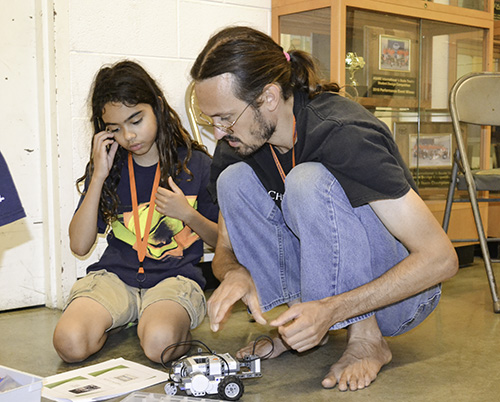
Above: A father-son team works to build Lego Mindstorm Robotics.
Below: A young participant and her dad work to build their robot during the Lego Mindstorm session.
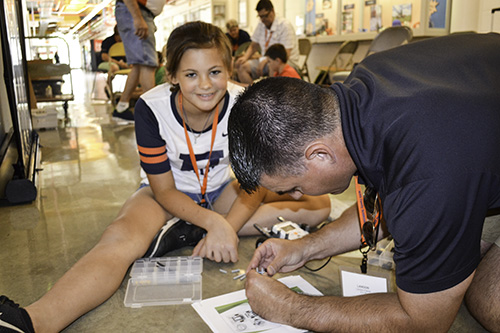
“A lot of our alums remember what they did when they were on campus,” she explains. “They remember the type of education, classes, professors that they had on campus, so it was really an opportunity for us to be able to showcase the college, showcase how the curriculum has changed, the focus has changed within the college.”
Regarding the public perception that ACES and agriculture are only about food production via crops and animals, Veal speaks to the changes and diversification that have occurred in ACES over the years and the wide spectrum of fields it comprises.
“We're very science-based; we have a lot of students that will come here to go on to medical school, to go on to vet school, to go on to do other things outside of necessarily the ag field… Especially in our Human Development and Family Studies—I mean, they're working in hospitals. It's just such a wide range… We really do touch all spectrums.”
In addition to the medical field, Veal indicates that ACES also uses and teaches technology, such as computer science, GPS. She indicates that there's a new curriculum starting in crop sciences next year that's computer-science based.
“You look at all of the technology that goes into ag engineering and that goes into our crops—You know, we have tractors that drive themselves, that are GPS-based, drones are GPS-based. Agriculture is very much changing; I think that's something that's important for people to understand, and know that those type of career opportunities are available for kids within our college.”
In addition to introducing alums to the “new ACES,” Veal indicates that another goal was to provide family-oriented activities. “We really have a strong belief in our family unit in the college. And it was an opportunity for our alumni to have that inter-generational experience—to bring grand-kids, kids, nieces and nephews, cousins (I've seen cousins come back to campus) and have that live-in, on-campus, educational, hands-on experience.”
Planners made sure there was time in the evening where families could walk around campus with their kids or grand-kids to show them the different buildings, dorms, classrooms, etc., they used to go to when they were on campus.

Tina Veal, Director of ACES Family Academies.
“It is so fun,” Veal explains, “because the kids are like ‘I saw where my grandma lived,’ so they really are having that inter-generational experience where they're sharing the ACES story with their kids.”
Veal, who has experience working with youngsters via 4-H, says that's what got her interested in developing this program, with the goal of recruiting kids into STEM and into ACES.
“Because I had worked with that younger audience, I knew that there was an opportunity here to be able to showcase our college to a younger generation and hopefully get them excited about STEM, science, engineering, food, and to help them to be able to know that maybe this is a place that they would want to come when they graduate…when they want to go to college.”
Story and photos by Elizabeth Innes, Communications Specialist, I-STEM Education Initiative (unless otherwise noted).
More: ACES, Illinois Legacies, K-12 Outreach, Open House/Expo, 2017
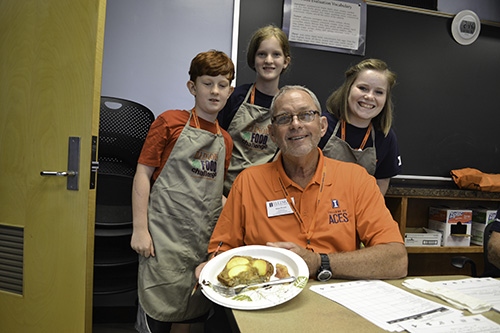 A team of students with the judge who tasted their food in the Food Challenge session.
A team of students with the judge who tasted their food in the Food Challenge session.

Rayna tasting butter that she made from shaking cream at the ACES lab.
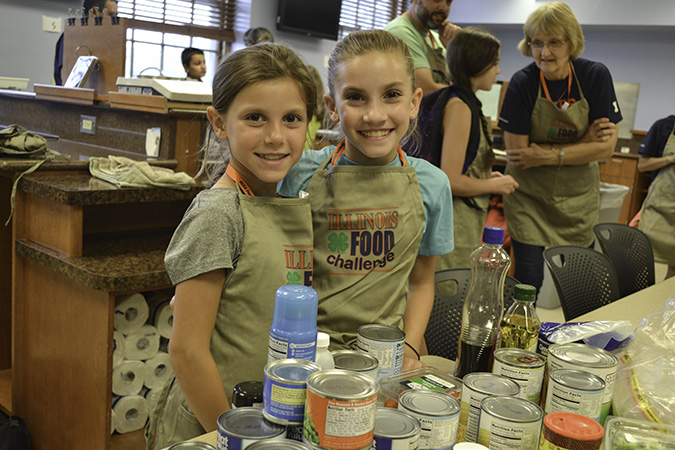
A team of students sort through possible ingredients during the "Food Challenge."
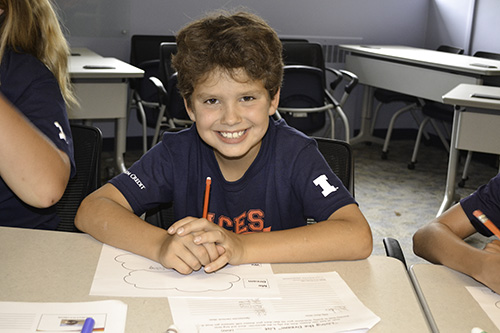
A young participant of the "Living the Dream" session puts his dreams and goals for his life on paper.
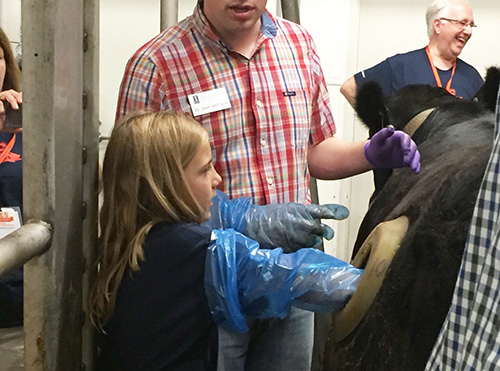
Rayna Brunk sticks her arm inside a cow's stomach. (Photo courtesy of Barbara Shearer.)













.jpg)
















